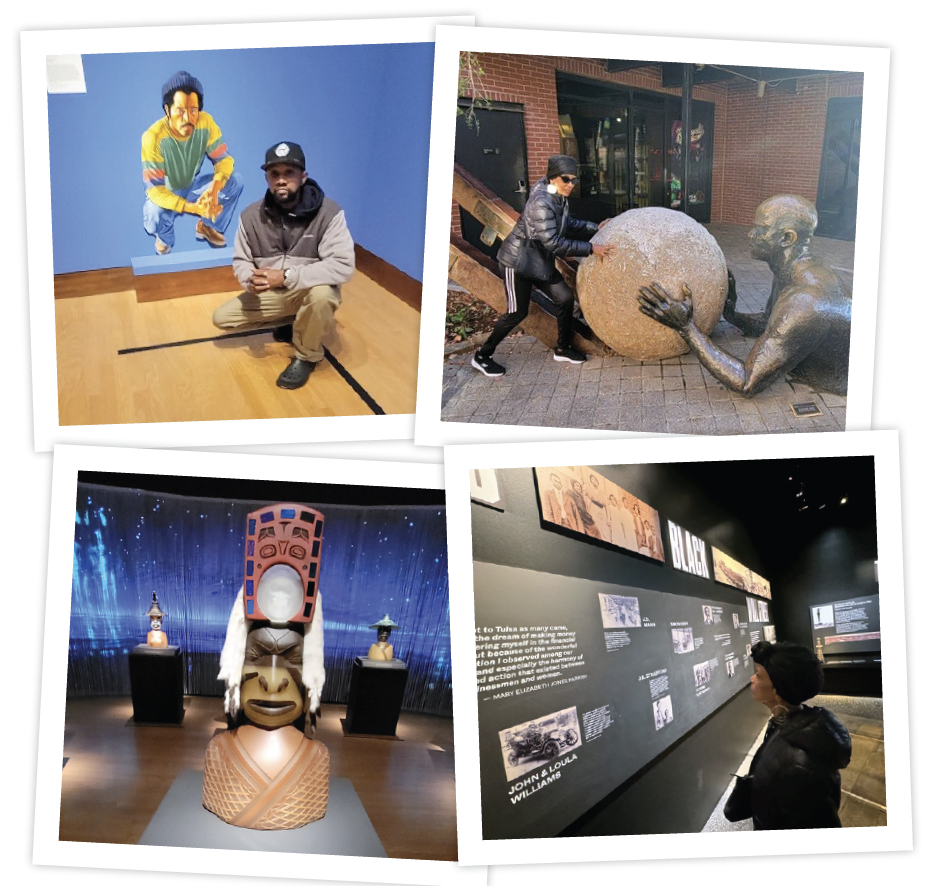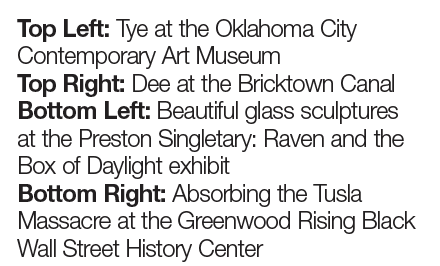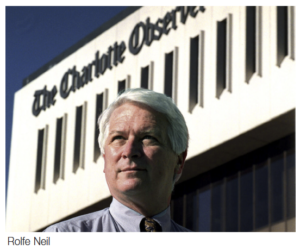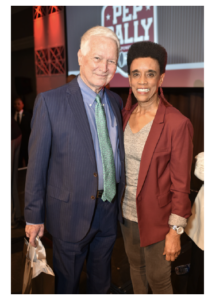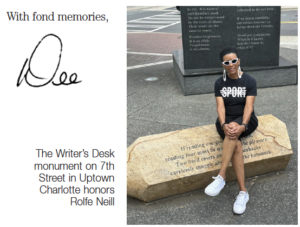Exploring Oklahoma City
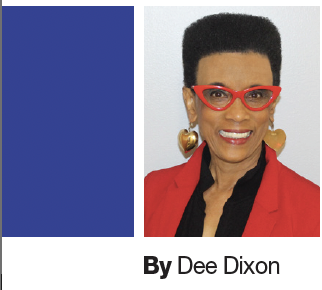 I chose Oklahoma City as my Thanksgiving travel destination in 2023 for three compelling reasons: I’d never been there, the Tulsa Race Massacre haunts me, and intriguing facts about Oklahoma’s Native American and Black History (particularly that of Bass Reeves) drew my attention. The word “Oklahoma” actually means “red people” as various tribes, including the Cherokee, Cheyenne, Chickasaw and Choctaw were mainly there. In addition, a little research revealed that between 1865 and 1920, there were approximately 50 all-Black towns in Oklahoma!
I chose Oklahoma City as my Thanksgiving travel destination in 2023 for three compelling reasons: I’d never been there, the Tulsa Race Massacre haunts me, and intriguing facts about Oklahoma’s Native American and Black History (particularly that of Bass Reeves) drew my attention. The word “Oklahoma” actually means “red people” as various tribes, including the Cherokee, Cheyenne, Chickasaw and Choctaw were mainly there. In addition, a little research revealed that between 1865 and 1920, there were approximately 50 all-Black towns in Oklahoma!I persuaded my son, Tye Feimster, to join me on this excursion. With great anticipation, we boarded a non-stop flight to Oklahoma City that took less than two hours on Thanksgiving morning. Upon arrival, we Uber-ed to our Hampton Inn & Suites hotel in the famous Bricktown section of the city and settled in. Bricktown was not all that. The restaurants were not enticing, and shopping in this area had a lot to be desired. No Black art. No unusual clothing shops. Walking along the Bricktown Canal was nice, though. Oh well, on to the museums.
We first visited the Oklahoma City National Memorial Museum that honors victims and survivors who were impacted by the Oklahoma City bombing on April 19, 1995. It was a very sobering experience, showing that evil is no respecter of persons.
My favorite museum visit was to the National Museum of the American Indian where we were exposed the most breathtaking exhibit ever. The Preston Singletary: Raven and the Box of Daylight exhibit was absolutely the most incredible multisensory experience I’ve yet to witness. I hope this exhibit comes to Charlotte.
We also visited the Oklahoma City Museum of Art, and the Oklahoma Black Museum and Performing Arts Center. We tried the American Banjo Museum but couldn’t stomach it. However, the Oklahoma State Capitol building was amazing, with an incredible display of art and history.
Our greatest adventure was a day trip to Tulsa to absorb the details of the Tulsa race massacre of 1921 at the Greenwood Rising Black Wall Street History Center. This experience was beyond powerful as we immersed ourselves in accounts from survivors and memories from descendants of one of the most brutal attacks in modern U.S. history that killed hundreds of innocent Black residents and destroyed well over 1,000 homes. Businesses completely obliterated — compensational and generational wealth blotted out.
Overall, this was a trip worth taking, although I’ll just give it a 4.5 rating. At least I know for sure it’s not a city I’d like to reside in, even though the cost of living is much cheaper than in Charlotte. The lack of walkability and the absence vibrant African American presence is depressing.
Onward!
Click “HERE” to view more OKC photos
Remembering Rolfe Neill – G.O.A.T.
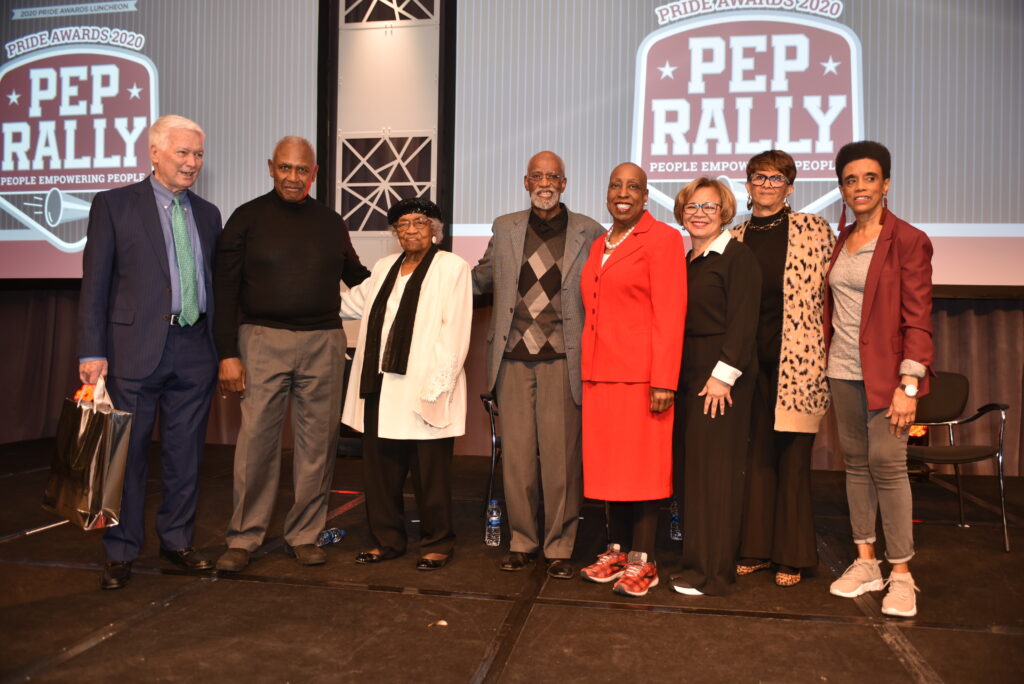
from the Publisher
Pride Awards 2020 – Left to right: Rolf Neil, Harvey Gantt, Thereasea Elder, James Ferguson II, Dr. Ophelia Garmon-Brown, Mayor Vi Lyles, Dorthy Counts-Scoggins, Dee Dixon
Rolfe Neill, one of Charlotte’s greatest leaders of all time, died on July 14, 2023. I had the privilege of experiencing first-hand the unique qualities of his leadership style when he was publisher of the “Charlotte Observer” during the late 80s and 90s. Without question, he opened a door of opportunity for me, which has led to a career in Charlotte, North Carolina, I never imagined in my wildest dreams.
The first call back from Rolfe
I’ve told this story often. Having moved back to my parents’ home with three children after a traumatic divorce, I was looking for a job — not a career. It was a harrowing time in my life. At one point, I read something in the Observer about the difficulty in finding qualified minorities to work. Livid and planning to give Rolfe Neill a piece of my mind, I called the Observer and asked to speak to him. As expected, I was told he was unavailable, so I left my name and number. To my surprise, Rolfe Neill actually called me back! I was dumbfounded. Long story short, with a recent master’s degree in urban administration, I ended up as an admin at the Observer in human resources.
For two years, Rolfe would occasionally ask me what I wanted to do at the newspaper. Finally, I responded by saying I wanted to sell advertising and thus began my career. A Black magazine — Community Pride — was born in 1993 during Rolfe’s tenure, and I was a part of the sales team.
I, along with many others, was saddened by Rolfe’s retirement in 1997. The quality that struck me the most about his leadership was his intuitiveness and uncanny ability to ask you a deep and unexpected question. He actually listened and remembered the conversation when he saw you again. It was a well-known fact Rolfe knew every employee by name and treated each with dignity and respect — no DEI training needed. After spending 14 years at the Observer, I left in 2001 as an entrepreneur, becoming the owner and publisher of “Pride Magazine.”
The final call back from Rolfe
Over the years, I periodically connected with Rolfe. In fact, he was one of the legends at our 2020 Pride Awards luncheon. It was such an honor to include him among such heroes as Ophelia Garmon-Brown, Harvey Gantt, Charlotte Mayor Vi Lyles, Dorothy Counts, James Ferguson and Thereasea Elder. Rolfe stood out as the only non-Black person on the stage. I was so very pleased to have him there!
Several months ago, I was saddened upon receiving the news Rolfe was in hospice. Reluctantly, I decided to give him a call, thinking he surely would be unable to talk. He did not answer, so I left a message. Shortly thereafter, he called me back — one last time! We talked and I was able to thank him for being such a meaningful part of my life’s journey.
Did you know there is a public tribute to Rolfe called the “Writer’s Desk” on 7th Street? It is a beautiful collection of quotes from his Sunday columns. I spent time reading them all. I like one in particular: “If we listen carefully, our critics instruct us better than our friends.” – Rolfe Neill

